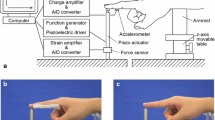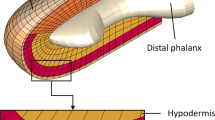Abstract
Vibrotactile perception threshold measurement has been widely used to diagnose the severity of peripheral neuropathy associated with hand-arm vibration syndrome and sensory losses in stroke and diabetic patients. The vibration perception threshold is believed to be influenced by many factors, such as contact force and vibration frequency. The present study is intended to analyze, theoretically, the time-dependent deformation profile of skin surface, strain distributions within soft tissue, and response force of a fingertip when it is stimulated by a probe vibrating with a sinusoidal movement. A two-dimensional finite element model, which incorporates the essential anatomical structures of a finger: skin, subcutaneous tissue, bone, and nail, has been proposed to analyze the effects of vibration amplitude, frequency, and preindentation on the dynamic interaction between the fingerpad and vibrating probe. The simulation results suggest that the fraction of time over which the skin separates from the probe during vibration increases with increasing vibration frequency and amplitude, and decreases with increased preindentation of the probe. The preindentation of the probe has been found to significantly reduce the trend of skin/probe decoupling. The simulation results show reasonably consistent trends with the reported experimental data. © 2003 Biomedical Engineering Society.
PAC2003: 8719Rr, 8719Bb, 8710+e
Similar content being viewed by others
References
Christensen, N. J.Vibratory perception and blood flow in the feet of diabetics. Acta. Med. Scand.185:553–559, 1969.
Clemente, C. D. Anatomy: A Regional Atlas of the Human Body, 2nd ed. Baltimore: Urban and Achwarzengerg, 1981.
Cohen, J. C., J. C. Makous, and S. J. Bolanowski. Under which conditions do the skin and probe decouple during sinusoidal vibrations?Exp. Brain Res.129:211–217, 1999.
Fawcett, D. Text Book of Histology, 11th ed. Philadelphia: Saunders, 1986.
Goble, A. K., A. A. Collins, and R. W. Cholewiak. Vibrotactile threshold in young and old observers: the effects of spatial summation and the presence of a rigid surround. J. Acoust. Soc. Am.99:2256–2269, 1996.
Goodwin, A. W., K. T. John, and I. Darian-Smith. Skin profiles during sinusoidal vibration of the fingerpad. Exp. Brain Res.77:79–86, 1989.
Gray, H. Anatomy of the Human Body, 29th ed. Philadelphia: Lea and Febider, 1973.
Harada, N., and M. J. Griffin. Factors influencing vibration sense thresholds used to assess occupational exposures to hand transmitted vibration. Br. J. Ind. Med.48:185–192, 1991.
Holmes, M. H., and V. C. Mow. Nonlinear characteristics of soft gels and hydrated connective tissues in ultrafiltration. J. Biomech.23:1145–1156, 1990.
ISO/FDIS-13091–1. International standard: Mechanical vibration—Vibrotactile perception thresholds for the assessment of nerve dysfunction—Part 1: Methods of measurement at the fingertips. Technical report, The International Organization For Standardization, 2001.
Kim, J. S., and S. Choi-Kwon. Discriminative sensory dysfunction after unilateral stroke. Stroke27:677–682, 1996.
Lindsell, C., and M. J. Griffin. Thermal thresholds, vibrotactile thresholds and finger systolic blood pressures in dockyard workers exposed to hand-transmitted vibration. Int. Arch. Occup. Environ. Health72:377–386, 1999.
Liu, W., L. A. Lipsitz, M. Montero-Odasso, J. Bean, D. C. Kerrigan, and J. J. Collins. Noiseenhanced vibrotactile sensitivity in older adults, patients with stroke, and patients with diabetic neuropathy. Arch. Phys. Med. Rehabil.83:171–176, 2002.
Mow, V. C., S. C. Kuei, W. M. Lai, and C. G. Armstrong. Biphasic creep and stress relaxation of articular cartilage: Theory and experiment. ASME J. Biomech. Eng.102:73–84, 1980.
Pan, L., L. Zan, and F. S. Foster. Ultrasonic and viscoelastic properties of skin under transverse mechanical stress. Ultrasound Med. Biol.24:995–1007, 1998.
Phillips, J., and K. Johnson. Tactile spatial resolution. iii: A continuum mechanics model of skin predicting mechanoreceptor responses to bars, edges, and gratings. J. Neurophysiol.46:1204–1225, 1981.
Rubin, M. B., S. R. Bodner, and N. S. Binur. An elastic-viscoplastic model for excised facial tissues. J. Biomech. Eng.120:686–689, 1998.
Storakers, B.On material representation and constitutive branching in finite conpressible elasticity. J. Mech. Phys. Solids34:125–145, 1986.
Tschoegl, N. W. The Phenomenological Theory of Linear Viscoelastic Behavior: An Introduction. New York: Springer, 1989.
Vallbo, A. B., and R. S. Johnson. Properties of cutaneous mechanoreceptors in the human hand related to touch sensation. Hum. Neurobiol.3:3–14, 1984.
Wan, A. W.Biaxial tension test of human skin. Biomed. Mater. Eng.4:473–486, 1994.
Wu, J. Z., R. G. Dong, S. Rakheja, and A. W. Schopper. Simulation of mechanical responses of fingertip to dynamic loading. Med. Eng. Phys.24:253–264, 2002.
Wu, J. Z., and W. Herzog. Finite element simulation of location-and time-dependent mechanical behavior of chondrocytes in unconfined compression tests. Ann. Biomed. Eng.28:318–330, 2000.
Yamada, H. Strength of Biological Materials.Baltimore: Williams and Wilkins, 1970.
Zhang, J. D., A. F. T. Mak, and L. D. Huang. A large deformation biomechanical model for pressure ulcers. ASME J. Biomech. Eng.119:406–408, 1997.
Zheng, Y. P., and A. F. Mak. An ultrasound indentation system for biomechanical properties assessment of soft tissues. IEEE Trans. Biomed. Eng.43:912–918, 1996.
Author information
Authors and Affiliations
Rights and permissions
About this article
Cite this article
Wu, J.Z., Dong, R.G., Schopper, A.W. et al. Analysis of Skin Deformation Profiles During Sinusoidal Vibration of Fingerpad. Annals of Biomedical Engineering 31, 867–878 (2003). https://doi.org/10.1114/1.1581290
Issue Date:
DOI: https://doi.org/10.1114/1.1581290




